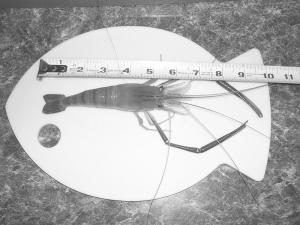2008 - Volume #32, Issue #2, Page #09
[ Sample Stories From This Issue | List of All Stories In This Issue | Print this story
| Read this issue]
Ohio Fish Farm Raises Shrimp, Stocks Farm Ponds
 |
A 1-acre pond can raise up to 2,000 lbs. of freshwater shrimp which can be harvested and sold fresh to buyers in one day, says Bob Calala, whose family has been involved in the industry for 44 years. The Calalas run a diverse nursery selling juvenile shrimp and yellow perch, largemouth bass and smallmouth bass fingerlings, and raising fresh water shrimp, soft-shell crayfish, fathead minnows and food and game fish. The family business has 60 ponds on 90 acres of water, plus tanks made out of grain bin rings for shrimp nurseries.
Calala nots that in Ohio there are already 200 licensed aquaculture operations.
"The largest expense is digging the ponds," he explains. He recommends rectangular ponds 6 to 8 ft. deep that can be drained, which makes them usable for raising fish or shrimp.
Shrimp bring the quickest return. In 100 days (with water temperatures that start at 70 degrees and stay above 60 degrees) they're ready to sell. Consumers want fresh, safe shrimp, Calala says, and selling them is the easy part. An article in the local paper and a couple of simple ads, resulted in cars lined up an hour before his sale started in 2006. He and his workers netted out 800 lbs. of shrimp, rinsed them off and sold them within three hours. Half the customers went home empty-handed. The following year, they sold 1,500 lbs. Customers bring their own ice and containers and pay $8/lb.
"If you want a second crop, you can stock rainbow trout," Calala says. "Put 8 to 10-in. trout in the pond in the fall, raise them until the ice is out, feed them and harvest them at 12 to 15 inches in April by having people come and fish them out of the pond for a couple of weekends." Because it's a form of entertainment, you can make more money than just selling them for stocking.
In the past, there has also been a good market for bait soft-shell crayfish, which sell for about $5/doz. in Ohio.
The Calalas' other market is selling game fish for stocking. That market takes a couple of years to establish, Calala says. It's also a limited market since once a pond is stocked, the fish reproduce, and the buyer doesn't need to buy more fish.
For the Calalas, diversification has helped them survive fluctuating markets and changing regulations. As president of the Ohio Aquaculture Association and a member of agriculture and natural resources boards, Calala is willing to share information with people interested in aquaculture. His business also sells juvenile shrimp (8 cents/apiece) to shrimp growers.
Though there are challenges with increased fuel and feed costs, the market is good, Calala says. "Consumers want fresh, locally grown food that they know is safe and naturally grown. if you build a pond, you can raise anything in it," Calala says.
Contact: FARM SHOW Followup, Bob Calala, 421 State Route 60 S, New London, Ohio 44851 (ph 419 929-8052; calala@earthlink.net

Click here to download page story appeared in.

Click here to read entire issue
To read the rest of this story, download this issue below or click here to register with your account number.




